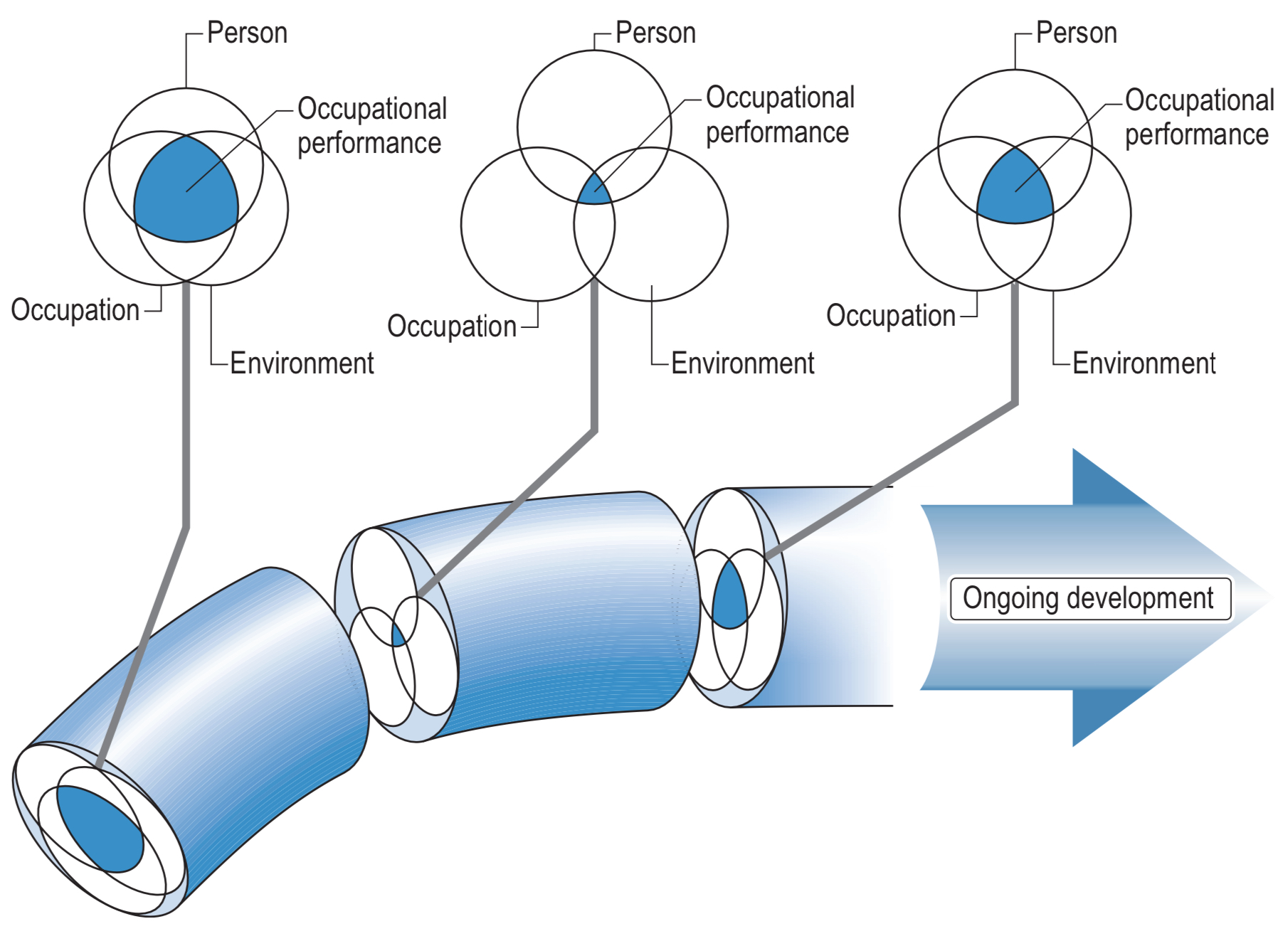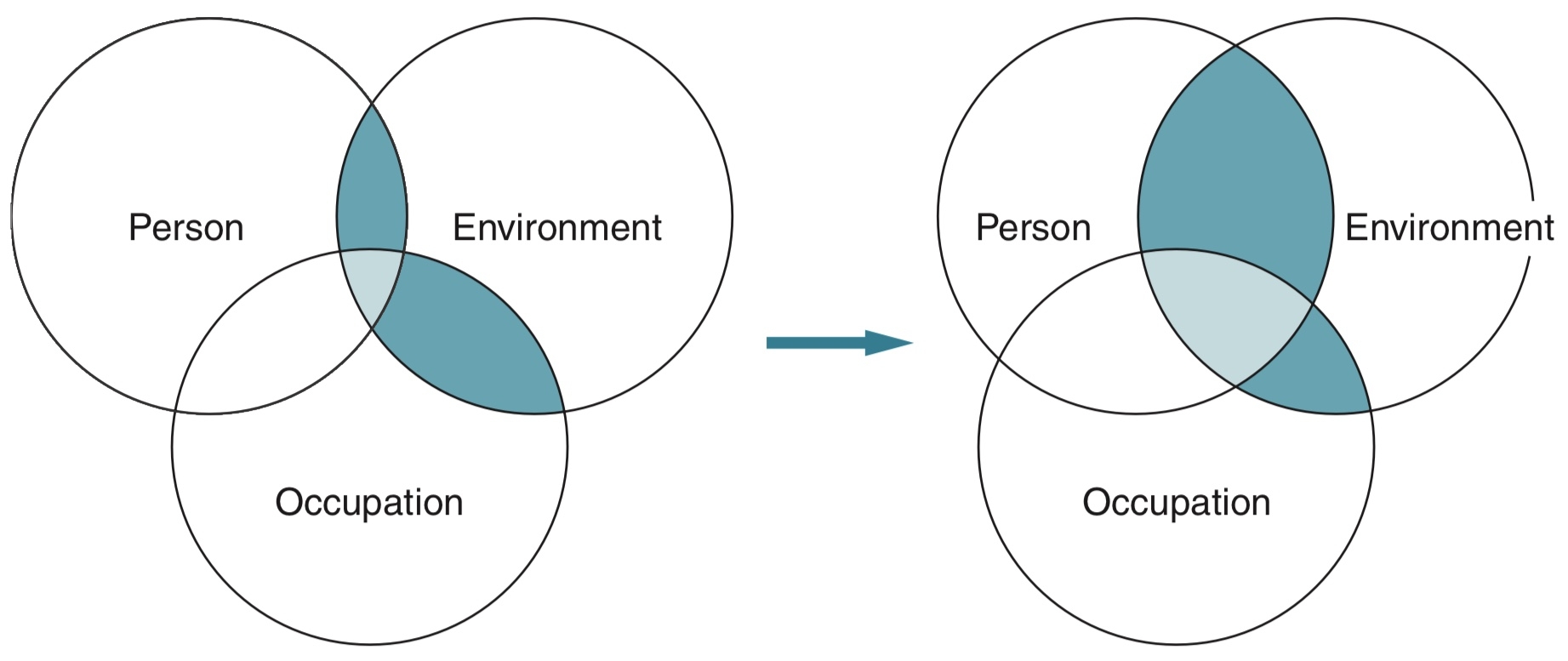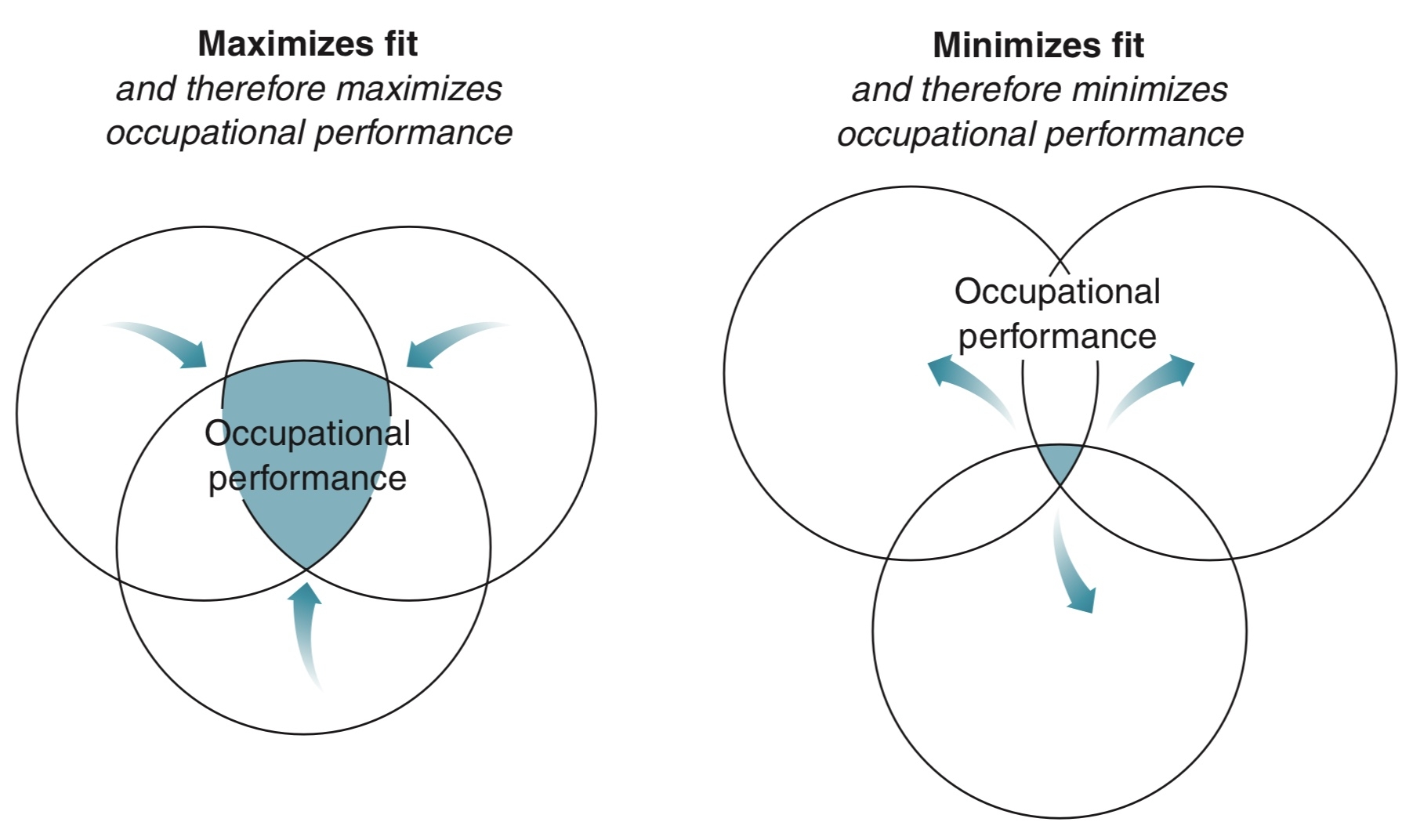


Figure 1a. A Person-Environment-Occupation Model of Occupational Performance.
Law, M., Cooper, B., Strong, S., Stewart, D., Rigby, P., & Letts, L., The Person-Environment-Occupation Model: A Transactive Approach to Occupational Performance, Canadian Journal of Occupational Therapy (Volume: 63 issue: 1) pp. 9-23. Copyright © 1996 by SAGE Publications.
https://doi.org/10.1177/000841749606300103
Reprinted by permission of SAGE Publications, Inc. This material is the exclusive property of the SAGE Publications, Inc. and is protected by copyright and other intellectual property laws. User may not modify, publish, transmit, participate in the transfer or sale of, reproduce, create derivative works (including course packs) from, distribute, perform, display, or in any way exploit any of the content of the file(s) in whole or in part. Permission may be sought for further use from SAGE Publications, Inc., attn. Rights Department, 2455 Teller Road, Thousand Oaks, CA 91360, Email: permissions@sagepub,com. By accessing the file(s), the User acknowledges and agrees to these terms. http://www.sagepub.com

Figure 1b. Depiction of the Person-Environment-Occupation Model of Occupational Performance across the lifespan illustrating
hypothetical changes in occupational performance at three different points in time.
Law, M., Cooper, B., Strong, S., Stewart, D., Rigby, P., & Letts, L., The Person-Environment-Occupation Model: A Transactive Approach to Occupational Performance, Canadian Journal of Occupational Therapy (Volume: 63 issue: 1) pp. 9-23. Copyright © 1996 by SAGE Publications.
https://doi.org/10.1177/000841749606300103
Reprinted by permission of SAGE Publications, Inc. This material is the exclusive property of the SAGE Publications, Inc. and is protected by copyright and other intellectual property laws. User may not modify, publish, transmit, participate in the transfer or sale of, reproduce, create derivative works (including course packs) from, distribute, perform, display, or in any way exploit any of the content of the file(s) in whole or in part. Permission may be sought for further use from SAGE Publications, Inc., attn. Rights Department, 2455 Teller Road, Thousand Oaks, CA 91360, Email: permissions@sagepub,com. By accessing the file(s), the User acknowledges and agrees to these terms. http://www.sagepub.com

Figure 2. An Illustration of Changes to Occupational Performance as a Consequence of Variations in Person, Environment
and Occupational Fit.
Law, M., Cooper, B., Strong, S., Stewart, D., Rigby, P., & Letts, L., The Person-Environment-Occupation Model: A Transactive Approach to Occupational Performance, Canadian Journal of Occupational Therapy (Volume: 63 issue: 1) pp. 9-23. Copyright © 1996 by SAGE Publications.
https://doi.org/10.1177/000841749606300103
Reprinted by permission of SAGE Publications, Inc. This material is the exclusive property of the SAGE Publications, Inc. and is protected by copyright and other intellectual property laws. User may not modify, publish, transmit, participate in the transfer or sale of, reproduce, create derivative works (including course packs) from, distribute, perform, display, or in any way exploit any of the content of the file(s) in whole or in part. Permission may be sought for further use from SAGE Publications, Inc., attn. Rights Department, 2455 Teller Road, Thousand Oaks, CA 91360, Email: permissions@sagepub,com. By accessing the file(s), the User acknowledges and agrees to these terms. http://www.sagepub.com

Figure 3. Effect of Intervention to Change Environment on Occupational Performance.
Law, M., Cooper, B., Strong, S., Stewart, D., Rigby, P., & Letts, L., The Person-Environment-Occupation Model: A Transactive Approach to Occupational Performance, Canadian Journal of Occupational Therapy (Volume: 63 issue: 1) pp. 9-23. Copyright © 1996 by SAGE Publications.
https://doi.org/10.1177/000841749606300103
Reprinted by permission of SAGE Publications, Inc. This material is the exclusive property of the SAGE Publications, Inc. and is protected by copyright and other intellectual property laws. User may not modify, publish, transmit, participate in the transfer or sale of, reproduce, create derivative works (including course packs) from, distribute, perform, display, or in any way exploit any of the content of the file(s) in whole or in part. Permission may be sought for further use from SAGE Publications, Inc., attn. Rights Department, 2455 Teller Road, Thousand Oaks, CA 91360, Email: permissions@sagepub,com. By accessing the file(s), the User acknowledges and agrees to these terms. http://www.sagepub.com

Figure 4. Occupational Therapy: The Person-Environment-Occupation Model of Occupational Performance
Law, M., Cooper, B., Strong, S., Stewart, D., Rigby, P., & Letts, L., The Person-Environment-Occupation Model: A Transactive Approach to Occupational Performance, Canadian Journal of Occupational Therapy (Volume: 63 issue: 1) pp. 9-23. Copyright © 1996 by SAGE Publications.
https://doi.org/10.1177/000841749606300103
Reprinted by permission of SAGE Publications, Inc. This material is the exclusive property of the SAGE Publications, Inc. and is protected by copyright and other intellectual property laws. User may not modify, publish, transmit, participate in the transfer or sale of, reproduce, create derivative works (including course packs) from, distribute, perform, display, or in any way exploit any of the content of the file(s) in whole or in part. Permission may be sought for further use from SAGE Publications, Inc., attn. Rights Department, 2455 Teller Road, Thousand Oaks, CA 91360, Email: permissions@sagepub,com. By accessing the file(s), the User acknowledges and agrees to these terms. http://www.sagepub.com
Law, M., Cooper, B., Strong, S., Stewart, D., Rigby, P., & Letts, L. (1996). The Person-Environment-Occupation Model: A Transactive Approach to Occupational Performance. Canadian Journal of Occupational Therapy, 63(1), 9–23. https://doi.org/10.1177/000841749606300103